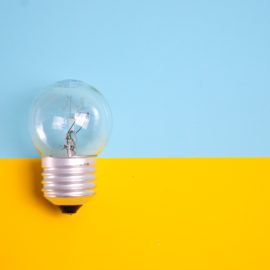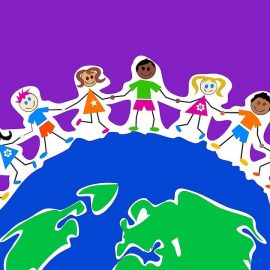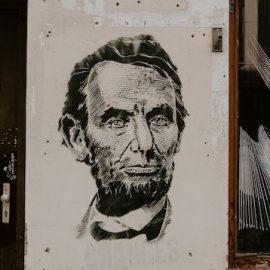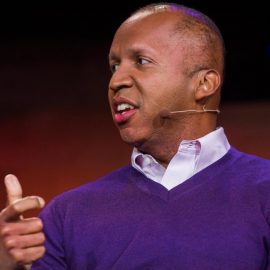
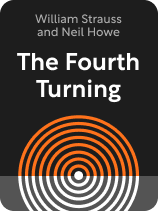
This article is an excerpt from the Shortform book guide to "The Fourth Turning" by William Strauss and Neil Howe. Shortform has the world's best summaries and analyses of books you should be reading.
Like this article? Sign up for a free trial here.
How do different generations function in society and react to societal changes? How did predictions about America’s future made in 1997 turn out?
In their book The Fourth Turning, William Strauss and Neil Howe explain that human history is characterized by a cyclical progression through four “Turnings,” which the authors liken to seasons. Identifying these Turnings can help us understand the past and possibly predict the future.
Continue reading for an overview of this insightful book.
The Fourth Turning Book Overview
Strauss and Howe, in their book The Fourth Turning, explain that each Turning lasts around 15 to 25 years (approximately the length of one of four phases of a human life—childhood, young adulthood, middle age, and elderhood). Each is defined by the behaviors of the generations passing through them, specifically by how they react to societal changes and events.
William Strauss (1947–2007) was an author, playwright, historian, and lecturer who worked for the U.S. Department of Energy and later the Subcommittee on Energy, Nuclear Proliferation, and Government Processes. Neil Howe is an author, consultant, and a senior associate for the former Global Aging Initiative at the Center for Strategic and International Studies. Together, Strauss and Howe authored several other books including Generations, 13th Gen, and Millennials Rising.
We’ll explore the four Turnings and the societal trends that accompany them. We’ll then explain the four generations that Strauss and Howe describe and their roles in society at different life phases. Finally, we’ll look at the past three Turnings in American history and the authors’ predictions for the Fourth.
The Four Turnings
A single cycle of these four Turnings is called a saeculum. Turnings aren’t characterized by the events that occur during them but rather by society’s reactions to those events. According to the authors, a First Turning is a High, a Second Turning is an Awakening, a Third Turning is an Unraveling, and a Fourth Turning is a Crisis.
The actions of a society can’t stop the cycle, but we can prepare for each Turning by studying previous cycles and the effects they had on society. We can then ease transitions by shifting our activities based on the Turning we’re currently in and anticipating the next one.
The First Turning: A High
According to the authors, a High occurs after a period of great turmoil is resolved. During a High, a new social order is put in place. Government is strong and active, and public services are expanded.
Values like individualism fall out of fashion and are replaced by more collective values. Income inequality and unemployment fall, and productivity increases. Class inequality also falls, but gender gaps increase. Children are given greater autonomy.
The Second Turning: An Awakening
An Awakening occurs when people pull away from the social order imposed during the High, resulting in a cultural revolution. People question and defy the institutions and regulations established during the High as the need for them falls out of living memory.
People also reject collective values and the ideals of duty and conformity in favor of individual rights. Government weakens, and free markets begin to overshadow public services. Violence and crime increase, as do income inequality and class divisions. Gender divisions become less strict, and child-rearing becomes more lenient.
The Third Turning: An Unraveling
An Unraveling occurs when society embraces the new order put in place during the Awakening. Trust in government and establishments continues to decline, and people become more passionate about and extreme in their beliefs. Communities become divided over morals, and unified action becomes more difficult.
People become tribal or nationalistic and suspicious of anything that doesn’t fit their values. Individualism is at its highest, and free markets become even more favored. Violence, crime, and income inequality reach their peak. Gender divisions are even less strict, and society becomes more protective of children.
The Fourth Turning: A Crisis
A Crisis occurs when a catalyst ignites a significant change in society. The anxious, pessimistic, and pre-cataclysmic mood of the Unraveling primes people to respond in a way that creates a societal upheaval.
These events create panic about the nation’s ability to handle such events. In response, people begin to unite as communities to establish a new social order that demands collective sacrifice to resolve the nation’s problems. The government is appointed to implement and enforce this social order, usually with mixed results.
Violence, crime, and income inequality decrease as the Turning progresses. Gender divisions increase again as women and the elderly are expected to leave the workforce to make room for young men. Protectiveness over children is at its highest.
Eventually, the Crisis peaks, and the social order is at its strongest. The risk of national violence such as revolution, civil war, and foreign war increases. Leaders characterize foreign enemies and political opponents as immoral and refuse to compromise, and the use of highly deadly or destructive weaponry increases for the sake of decisive victories in war.
As a result of the Crisis, society is unrecognizably transformed. The resolution of the Crisis cements the new social order and results in an end to wars.
Generational Archetypes
According to the authors, each generation in society fits into one of four different archetypes: the Prophet generation, the Nomad generation, the Hero generation, and the Artist generation. The birth range of a generation is about 15 to 25 years—approximately the same length as a Turning—and the pattern proceeds almost universally in this order.
Archetypes and Their Roles
The authors explain that, for every archetype, each phase of life is accompanied by unique social roles. The childhood phase is defined by receiving support from others and learning morals. The way society views and treats children varies with the Turnings.
Young adulthood is defined by service to society and the testing of morals. It’s the age where people are building and pursuing their dreams, forming families, and carrying out the work that keeps society moving such as lower-level work and military service. The degree to which young adults respect and carry on the work of older generations varies with the Turnings.
Midlife is defined by managing society and upholding morals. This is when people are reaping the rewards from their work during young adulthood, making their dreams a reality, and beginning to take on leadership roles in society.
Elderhood is defined by leading society and passing on morals to younger generations. People are relieved of the burden of work and spend their time in leisure and recreation, or they take on society’s most powerful leadership positions. The influence that Elders have on society shifts with the Turnings between culture and politics.
As they go through the phases of life, the archetypes take on new roles and characteristics, such as the following:
- Prophets are born during a High. In childhood, Prophets are coddled, and they grow into self-centered rebels who seek societal change. They are judgmental in midlife but can provide wise judgment in their elder years.
- Nomads are born during an Awakening. In childhood, Nomads are loosely parented or neglected. They feel estranged and are stigmatized in young adulthood, but they become sensible mid-lifers who provide practical leadership, and they’re hardy and reliable in elderhood.
- Heroes are born during an Unraveling. In childhood, Heroes are heavily protected. They have a strong sense of teamwork, duty, and self-sacrifice in young adulthood, but grow arrogant in midlife. As elders, they find the values they fought for under attack by the Prophet young adults.
- Artists are born during a Crisis. In childhood, Artists are overprotected. In young adulthood, they’re thoughtful and deferential. They make for ambivalent midlife leaders and compassionate elders.
The generations both shape and are shaped by the Turnings as they pass through them. Below, we will explain Turnings and how the generational archetypes play into them.
America’s Most Recent Turnings
The authors published this book in 1997, at which point they explained that the US was nearing the end of a Third Turning. America’s current saeculum began in 1946, just after World War II (America’s most recent Crisis), which is where we’ll start.
The American High: A First Turning
The First Turning of our current saeculum lasted from 1946 to 1964, explain the authors. With the Crisis of the war over, the G.I. generation returned from war with renewed optimism and a sense of collective purpose. They were welcomed back home as brave champions and began forming secure, prosperous families.
During this Turning, the elder Lost (Nomad) generation was leading with the wisdom built by living through two world wars and the Great Depression. They willingly and self-sacrificially paid high taxes to support the younger generations. The (Hero) G.I.s in midlife built their nation to its greatest point in history so far. The young adult Silent (Artist) generation married early and avoided risk, working mostly to help the older and younger generations in their efforts rather than pursuing a generational cause of their own.
During the American High, trust in government and institutions was high, and governing power was strong and had plentiful resources to implement social change. Income inequality dropped and the middle class flourished. As families grew, their need for housing increased as well, leading to the mass building of suburbs. However, beneath the upbeat mood of the High, racism and sexism brewed, materialism was rampant, and nonconformity was stigmatized.
The Consciousness Revolution: A Second Turning
The Awakening that followed the American High lasted from 1964 to 1984, and the authors termed it the Consciousness Revolution. According to the authors, its beginning was sparked by the assassination of John F. Kennedy at the end of 1963, which shook the nation and incited new social movements rebelling against the now well-established government and social institutions from the High.
Confidence in the nation’s G.I.-built institutions—such as government regulation and spending, labor unions, and corporations—began to waver. People no longer accepted the costs of these institutions, which included the massive power of corporations compared to individuals, police abuse of the poor, and the suffocation of creativity by academia.
Boomer Prophets entered young adulthood with no memory of the wartime plights that necessitated these systems. Hero G.I.s (now elders) watched on as the Boomers rebelled against what they had built. Simultaneously, Boomers and the Silent Artist generation (young adults and midlifers) were raising Nomad Xennial children with hands-off parenting styles and little supervision, as the normalization of no-fault divorce led to the highest divorce rates the nation had ever seen.
Violence spread, both in the public eye with the assassinations of Martin Luther King, Jr., and Robert Kennedy and on a smaller scale with protests against government and institutional overreach. The Vietnam War further eroded public faith in leadership, not only because it lacked the moral righteousness of World War II, but also because the young Boomer generation rejected the idea that duty to the country outweighed individual rights. As with the moon landing, people felt that the resources spent on this endeavor would be better applied on the homefront to ending poverty and social and racial inequality.
The clash between social movements and American materialism led to economic conflict in the 1970s. Environmentalist movements called for a reduction in energy consumption and construction, which led to a decrease in economic supply while demand for goods stayed the same. Inflation from fluctuating oil prices added to this economic crisis and resulted in a stagnation of wages that America still hadn’t recovered from by the time of this book’s publishing in 1997.
The focus on the individual created a culture of self-centeredness that rejected the idea of duty to one’s nation. At the beginning of the Awakening, young people’s focus on individual rights related mostly to civil rights and issues of culture. However, as the Turning came to a close, individualist sentiment spread to the realm of politics and economics. Conservatives embraced this new ideology and capitalized on the country’s newfound fierce individualism to reignite the Republican party, electing Ronald Reagan, whose first term brought the end of the Awakening.
The Culture Wars: A Third Turning
The Culture Wars following the Consciousness Revolution began in 1984 and were still ongoing at the time of this book’s publication in 1997. The authors roughly estimated that it would last through 2005 but acknowledged that it could end a few years earlier or later. During this time, the new system of individualistic values established during the Awakening had become part of mainstream culture.
The elder Silent Artist generation led ineffectually and indecisively during this time. Though this was the era when they should have been dominating the highest leadership roles, they failed to produce a single president during this Turning, a generational anomaly that had never happened before in U.S. history. They instead took on helper roles as White House staff and congresspeople, but the authors note that their generation of leaders has become notorious for working diligently but getting very little done. They explain that, compared to the G.I. leaders in the 1960s, the Silent leaders in the 1980s had twice as many hearings and four times the staff, but only one-third as many laws passed.
Meanwhile, Boomer Prophets entered midlife as judgmental leaders heavily fixated on black-and-white values that they were unwilling to compromise on. Xennial Nomads came into adulthood feeling alienated and ignored and with a fragmented generational identity.
Trust in the government reached its lowest point in the saeculum, but polls showed a high level of individual self-esteem. People began dividing into groups based on shared interests or characteristics such as gender, race, class, and religion, which led to discord between groups and a lack of unifying public sentiment. Each group saw themselves as victims of their opposing group, and paranoia fed these beliefs. Distrust grew between social groups of every kind.
The three main cultural “wars” during this time were over inclusivity and diversity, religion, and free market economics. Citizens, politicians, and the media all chose sides and stuck to them staunchly. Individuals on both sides of these conflicts viewed the other side with vitriol and deemed them stupid or evil. Voters became more polarized, with polls during the 1994 election showing a greater ideological divide than the nation had ever seen, and the number of independents and nonvoters grew. Politicians and political ads became brutally hostile.
Income inequality continued to grow, and homeless people were funneled out of shelters and public spaces into prisons. Companies laid off workers while their stocks continued to grow. Society became cynical, fragmented, and mistrustful—both of other people and of the government. There was a general sense that society was declining and heading toward disaster and there was nothing that could be done about it.
Predictions About the Crisis
The authors predicted that the Fourth Turning—a Crisis—would begin within the first few years of the 21st century, around 2005. Because the catalysts for a Fourth Turning are always foreseeable based on the trends that are established during the Unraveling, the authors make a handful of predictions about what the next catalyst might look like:
A terrorist attack by a foreign group purporting to have nuclear weapons, leading the US to declare war and begin searching people’s homes. Suspicions that the president fabricated the event would lead to a nationwide strike and the loss of foreign capital.
A new, highly contagious virus spreads, resulting in significant deaths and causing the government to create and enforce quarantines. The National Guard is deployed to isolate areas hit hardest by the disease, and the president is pressured to declare martial law.
Conflicts in and around Russia result in civil wars and the capture of American diplomats, leading the US to send ships into the Black Sea and Congress to consider reinstating the draft.
The authors note that these exact scenarios are unlikely and that whatever does happen, the nation will be able to mitigate it before it becomes truly devastating. However, it will arise from some problem that the country had failed to deal with soon enough, which will spark outraged calls to action.
After the Catalyst
As a result of the catalyst, the authors predicted that people would lose all faith in the government, struggle financially and begin to panic about their future and that a recession or depression may occur. People will have to form a new social order, peacefully or otherwise.
One political party will achieve a decisive win early in the Crisis and will maintain its power throughout the Turning. Its leaders will exaggerate and deliberately exacerbate the country’s problems to accelerate change and enact a more and more extreme agenda.
At the beginning of the Turning, income inequality will stop growing. Toward its end, the economy will begin to recover and may become stronger than ever. It will be more unionized and more independent from the global economy. The public will again trust the nation’s institutions and demand that they restrict choices by standardizing certain options in goods and services and by establishing a single dominant political party to relieve people of the onus of having to choose.
The rights of certain groups will come under attack by powerful organizations. Criminal justice will become increasingly harsh, and the harming of innocent people will become acceptable collateral damage for protection against those considered dangerous to society.
Through some combination of larger conflicts, the nation’s issues will coalesce into one large problem that forms the climax of the Crisis. People will unify around this problem, setting aside differences for the purpose of healing the nation and putting it on track for a new rebirth in the upcoming High. Whether the results of the Crisis’s resolution are positive or negative, the nation will be unrecognizable from what it was at the beginning of the Crisis.

———End of Preview———
Like what you just read? Read the rest of the world's best book summary and analysis of William Strauss and Neil Howe's "The Fourth Turning" at Shortform.
Here's what you'll find in our full The Fourth Turning summary:
- How Anglo-American history follows a pattern of four 15 to 25-year periods
- How the behaviors of different generations define these Turnings
- Predictions about the next Turning—a Crisis

